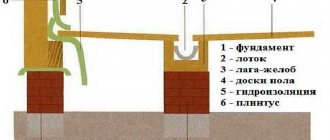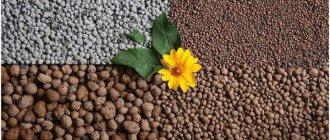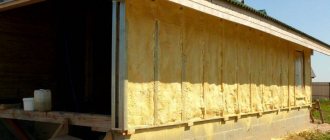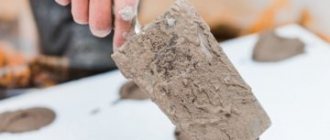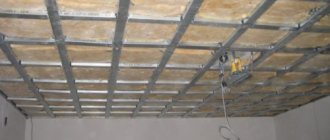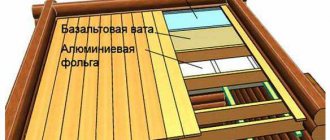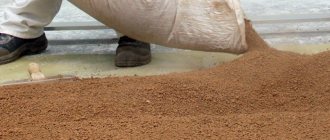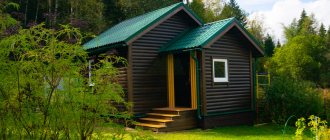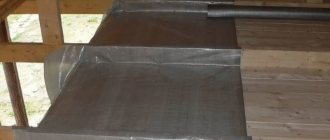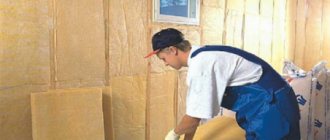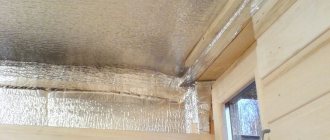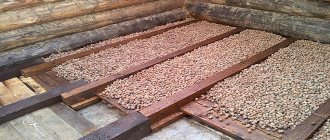Lining is a finishing material; it is attached to the walls when all other work has been completed, including insulation. Consequently, one should ask the question of how to insulate a bathhouse from the inside under the lining long before its installation begins. However, it also happens differently - the bathhouse has been finished for a long time, but you are not satisfied with the way it holds heat. And then you need to think about how to properly insulate the bathhouse under the lining in order to eliminate the problem with thermal insulation. Of course, it will have to be dismantled for a while. And then proceed exactly as if you were just building.
Types of suitable insulation materials
In our opinion, it makes sense to divide the types of thermal insulation materials for baths into sheet, roll and backfill. In addition, there are insulation materials that are applied to the walls in the form of foam or a moistened mass - these are polyurethane foam and ecowool, which are sprayed using special equipment.
Mineral wool can be purchased in rolls or sheets.
It all depends on its density and the binders used. BY THE WAY! We rarely name specific brands, but do you understand that the names Rockwool or Isover hide the same mineral wool produced by different companies?
Basalt wool is a type of mineral wool, a literal reference to the similar mineral used. There is practically no difference.
Basalt wool for baths
But you should not glass wool
Glass wool should no longer be used anywhere, because it is extremely unpleasant for humans - if it gets on the skin, it causes itching, and is hazardous to health if it gets into the eyes or respiratory organs. Yes, and fiberglass crumbles during operation, turns into dust, and it penetrates through the cracks, and you breathe it.
Does not like fiberglass insulation and elevated temperatures typical of a bathhouse.
Polystyrene foam and extruded polystyrene foam are good insulation materials, especially the latter, but using them in a bathhouse is dangerous. They are absolutely not suitable for a steam room, but could (theoretically) be used in other rooms, but we will not recommend them, since they are a fire hazard.
ADVICE! In the bathhouse, polystyrene foam and penoplex can be used in floors under concrete screed - there they do not pose any danger.
So, sheet insulation is mineral wool, foam glass (excellent, but expensive insulation), calcium silicate and magnesium silicate sheets, non-recommended polystyrene foam and extruded polystyrene.
Foam glass
Roll insulation is again mineral wool (lower density), glass wool. foamed polyethylene, with or without foil (penofol, isolon, etc.).
We have already spoken about fiberglass, now about foamed polyethylene . It is often used as additional insulation in residential buildings, but polyethylene does not tolerate high temperatures, so you should not use it instead of foil to insulate a steam room.
Foil insulation Penofol
IMPORTANT! Polyethylene already melts at a temperature of one hundred degrees. By the way, it supports combustion.
In general, it is quite possible to insulate other rooms of the bathhouse with it (as a second layer).
bulk insulation for baths into those that can be moistened and “glued” to the wall, and those that cannot. Expanded clay and vermiculite belong to the second category, ecowool - to the first.
Expanded clay and vermiculite can be used to insulate floors and ceilings, where they adhere perfectly and retain heat indoors. In order to insulate the walls of a bathhouse with them, it is necessary that between the two layers of the main wall material there is a gap, a cavity that can be filled with insulation.
Expanded clay
Ecowool is waste paper (cellulose) crushed into dust, impregnated with fire retardants so that it does not support combustion. And it really doesn’t support it - this is a good material for insulating baths where it is on sale. Ecowool is used in dry and wet form. In dry conditions - for insulating floors and ceilings, as well as for filling cavities. When wet - for application to walls.
Insulating the roof with ecowool using the wet method. Cromwell Photos
Also on our website you can read two articles that provide a more complete overview of insulation materials that can be used in a bathhouse:
- review of bath insulation;
- choosing the best of natural and artificial insulation for a bath.
Insulation of bath walls from the inside
If thermal insulation is planned to be made on the basis of mineral fiber mats, then the wooden walls must first be treated with antifungal impregnation, preferably alcohol-based. It is impossible to paint or varnish the inside; this can lead to the formation of cracks in the logs or beams. Next, we stretch the vapor barrier film onto the walls and fasten the panels with a stapler.
Classic version with mineral wool and foil inside
The next step is to make markings, stretch paint cords along the walls or install a laser level. It is important that the frame of the sheathing is flat and in a strictly vertical position. Therefore, to make a “corset” of insulation, we use slats with a cross-section of 120x20 mm and fasten each of them to the wall of the steam room with one self-tapping screw screwed into the head. The rail should not reach the floor by 35-40 mm.
After the vertical guides have aligned under their own weight, we attach them to the walls with a sliding fit. This means that a hole with a diameter of 4 mm is pre-drilled at the fastening point, after which a nail with a cross-section of 3 mm is driven in. As a result, the rail is stuck to the wall, and at the same time, due to the gap, it has the opportunity to move slightly.
All that remains is to cut in the horizontal jumpers from the inside of the slats, lay the mats 100 mm thick and secure them with ordinary tape. The last stage is laying foil thermal insulation; it is sewn onto the sheathing with staples and must be glued at the joints. Slats are sewn on top of the foil to install the lining of the sauna steam room.
Insulation from the inside of the walls of the bathhouse with polystyrene foam is carried out according to standard methods. Thermal insulation of the walls is formed from two layers of EPS with mandatory gluing of the joints. The insulation is fastened using mounting mushrooms. The finished layer of insulation from the inside of the room must also be covered with aluminum foil. In this case, the decorative trim of the steam room is stuffed onto wooden slats laid on the walls under the floor and ceiling of the room.
Insulation under the lining in bathhouses built from different materials
How does wall material affect the choice of thermal insulation? Let's take a consistent look at the options of what we can build a bathhouse from and compare the material and insulation technology.
Brick
Brick baths are cold and non-flammable. The first circumstance prevents them from becoming traditional, because a cold bath (almost made of stone) needs to be heated for a long time, which is not particularly welcome in our fast-paced age.
But the fact that it won’t burn is a big plus, considering that bathhouses burn most often.
So, it is precisely in order to reduce the disadvantages that thermal insulation should be used - it is most effective in buildings of this kind.
IMPORTANT! Thermal insulation of a brick structure can be not only internal or external, but also located between two layers of brickwork.
The latter circumstance increases the possibility of choosing insulation. Filling with expanded clay or ecowool is an excellent solution. Ecowool, for example, is used in “double timber” structures, and it works great for decades.
You can also fearlessly fill the gap with polyurethane foam - this is expensive, requires hiring a team with equipment, but it is reliable and safe, because polyurethane is flammable, and in the gap between the layers of brick nothing threatens it, including ultraviolet radiation, which destroys it.
In other cases, traditional mineral wool - most often because, despite all its shortcomings, it does not support combustion, and high-quality material does not emit volatile organic matter, which is harmful to health.
You can learn more about the technology of insulating a brick wall from this article.
Blocks
Of course, a brick is also a block, but in practice we more often call products made from slag concrete, foam concrete, or aerated concrete . Of course, they are larger and more similar to blocks, but they still have more internal similarities than bricks.
The fact is that high-quality brick does not crack, holds fasteners well, and does not absorb moisture. In essence, it is baked clay, almost stone. And concrete blocks either contain light (by density) impurities in the form of slag, or are foamed in one way or another, that is, they contain air bubbles.
Bathhouse made of foam blocks. Photo StroyDom
You can learn more about the similarities and differences between various foam concrete and slag concrete from here.
Both have a strong impact on a number of qualities. significantly reduced ; they themselves retain heat perfectly even without insulation. But most of them are afraid of water, all of them do not hold fasteners well (driving a nail into such a wall is problematic, but what about fastening door frames, for example?). Destroying blocks is quite easy.
But we are talking about thermal insulation. Do blocks need it? Yes, it is needed in the bathhouse and living space, especially if the climate is harsh. But in addition to thermal insulation, it is worth taking good care of the waterproofing of the wall material. To do this, it is covered with all kinds of films and membranes.
Mineral wool is also afraid of water, so it is better to fear blocks and mineral wool together, under a layer of vapor and waterproofing inside and outside. You will find the construction of a proper thermal insulation cake in this article.
Frame
A frame structure, in essence, is insulation between slats, covered on both sides with OSB boards, boards, and other sheet material.
In other words, insulation is the main one of the two or three materials that make up the wall . Therefore, there is no need to carry out any additional work on thermal insulation if the initial calculation was made correctly and you selected the right insulation thickness.
Frame wall pie. Read more about insulating frame walls here.
The standard “pie” , that is, the layers that make up the wall of a frame structure, is as follows:
- if you start from the inside, then the first layer will be finishing, for example, lining;
- the lining is nailed onto the sheathing, which is attached to the frame posts;
- under the sheathing there is a mandatory layer of vapor barrier, that is, a material that is one hundred percent impenetrable to water vapor - this can be plastic film or foil;
- the vapor barrier directly covers the insulation, which is most often mineral wool, but can also be reed slabs, a mixture of sawdust and gypsum/cement/clay, or ecowool;
- the insulation is located between the frame posts, equal in layer thickness to them;
- Next comes, for example, an OSB board, covering the thermal insulator from the outside and imparting rigidity to the structure;
- a membrane or waterproofing film is mounted on top of the wall panel, which is permeable to water vapor on the insulation side and impenetrable on the other side;
- External wall trim is attached on top of the waterproofing.
More detailed information about frame insulation technologies can be found in this article.
Tree
Wooden baths are either log houses, that is, they are built from cylindrical logs, or from timber - logs with a square or rectangular cross-section.
Traditionally, such baths do not require additional thermal insulation at all if the inter-crown insulation is properly installed and the cracks between the crowns are caulked . Tow, moss, and flax can be used as caulking material . But for laying between the crowns at the construction stage, it is most often recommended to lay strips of jute.
Natural insulation in a bathhouse is preferable, but in addition, you can use modern wood sealants, which have a certain elasticity, which allows them to change dimensions along with the wood, which “breathes” even after the structure has completed its final shrinkage.
If, during the operation of the bathhouse, it turns out that the thickness of the timber or log house does not correspond to the severity of the climate, then additional insulation has to be done. This is also a standard “pie”, consisting of lining, lathing, vapor barrier and insulation, the latter being attached directly to a wooden wall.
This article explains how a timber bathhouse is insulated.
Aluminum foil for bath insulation
Thermal insulating material for a bath should be highly resistant to high temperature and humidity. Aluminum foil has these properties, and therefore is one of the most popular insulation materials in baths. It is used both in combination with other materials and without them, depending on the thickness of the walls and operating conditions.
Aluminum foil for bath insulation
How to properly insulate a steam room
A steam room is the main bathing room from which visitors expect certain properties, in particular long-term heat retention. To do this, the steam room is insulated, but this must be done taking into account the preferences of certain traditions.
The fact is that in a Russian bath, long-term heating and retention of heat is carried out due to long-term heating by the same brick oven. Slowly heated wooden surfaces give off heat for just as long. If the thickness of the walls is not small and there are no cracks in them, then additional insulation is not required.
In addition, the Russian bath does not strive for high temperatures. If you make a “thermos” in it, this may become an obstacle to maintaining fairly low temperatures (40-70 degrees) characteristic of this type of national bath. Thermos is made using foil.
For more information about using foil for the ceiling, see this page.
As for the Finnish bathhouse - sauna, the task here is precisely to reach the set high temperature in the steam room in the shortest possible time and maintain it until the end of the procedures, subject to intensive air exchange.
It is worth insulating the steam room only if there are real problems with heat loss.
ADVICE! Focus on the material of the walls: in a brick bath, thermal insulation of the steam room is required, in a frame bath the thickness of the walls is included in the design, in a block bath it can be moderate, with a greater emphasis on waterproofing, and in a wooden bath it may not be necessary at all.
About the “thermos” a little lower, but otherwise the insulation scheme looks standard - most use mineral wool , because in fact there are not so many options for insulation in the bathhouse under the steam room lining. But even if it is mineral wool, you need to pay attention to the fact that it is intended strictly for saunas and baths - this means that it has a low content of phenols and other harmful substances in the bond for stone fibers.
In addition to mineral wool , ecowool, clay with sawdust and some other materials that are harmless to health can be used in the steam room of the bath
You already know that the insulation is placed directly on the wooden walls of the bathhouse; in other cases, it is separated by a vapor barrier on one side and a waterproofing barrier on the other. This applies to insulation materials that are afraid of moisture and lose their insulating properties due to its action.
You can read more about materials and technologies for thermal insulation of steam rooms in this and this article.
Basalt wool, specially designed for baths and saunas
Foil
Foil always causes fierce debate. The debates themselves are divided into two categories: is foil needed in a Russian bath and what is its effectiveness in reflecting heat.
Let's start with the fact that mirror surfaces have long been used to focus and redirect various types of radiation, including infrared - remember the design of the same reflector. The lining in the bathhouse does not interfere with infrared radiation.
IMPORTANT! But there is an essential condition for the mirror surface to work as a reflector - there must be air in front of the foil. The contact of other material to the foil on the reflection side is unacceptable. The ventilation gap from the foil to the lining is just right.
As for the use of foil in a Russian bath, there is, of course, no categorical prohibition, but it is advisable that you have ways to regulate the temperature , for example, using ventilation and the stove itself. In a steam room with an iron stove without a brick or stone lining, with foil insulation, you will get a hard version of the sauna, which does more harm than good.
We have two articles in which we analyze the types of foil and the arguments for and against its use in the bathhouse - the choice of insulation with or without foil, types of foil and arguments.
Which foil for a bathhouse is better to choose: and in general, is it worth insulating a bathhouse with foil from the inside?
Foil for a bath, which one is better to choose, and is it needed at all? This question arises for all owners of suburban areas who have decided to acquire their own steam room. Experts consider foil to be one of the most important materials when decorating bath rooms, since they must quickly reach the required temperature and retain heat for a long time.
What foil for a bath is better to choose?
For this purpose, insulation is installed on the surface of the walls and ceiling, which will block the exit routes for the generated heat outside the bathhouse. Almost always, the traditional insulating “pie” created on the internal surfaces of this structure includes aluminum foil, produced in different versions.
However, we have to admit that this material, which is welcomed by some users, is completely rejected by others, and there is an irreconcilable dispute between these “camps.” Therefore, it is worth figuring out how necessary this thermal insulation material is, or whether you can do without it. At the same time, let's see how the installation should be done so that the created insulation layer works properly.
Do you need a foil layer?
To insulate bath rooms, a thin layer of aluminum foil is usually used, the thickness of which averages from 30 to 300 microns. It can be applied to kraft paper, directly to insulating material, or it can be used separately from them and used in combination with other heat insulators.
There are both supporters and opponents of using foil to insulate baths
Expert opinion: Afanasyev E.V.
Chief editor of the Stroyday.ru project. Engineer.
Opponents of the use of foil argue that it is of no use, since aluminum has high thermal conductivity and therefore is not able to retain heat in the room - it will freely escape outside. In their opinion, it turns out that purchasing and installing foil material is a waste of money and effort. It should be noted that to some extent this is completely fair, since the foil will “work” only if its installation is carried out according to all the rules.
- The high thermal conductivity of aluminum foil will manifest itself negatively if it is attached directly to a cold wall made of materials such as brick, concrete or foam concrete, without an additional insulating layer between them.
The “lion’s share” of the thermal energy given off by sauna stoves comes from infrared radiation
- Secondly, in addition to the high thermal conductivity of the material due to its structure, which is unable to retain heated air inside the bathhouse, there are other methods of heat transfer - these are convention and infrared radiation. Thus, a hot stove releases the generated heat into rooms mainly in the form of infrared rays, which heat surfaces when absorbed.
When heat rays hit a layer of aluminum foil, they are not absorbed by it, but are reflected from it back into the room. Thus, thermal energy is not wasted on heating the walls, but is usefully used inside. Therefore, it follows that the foil retains heat not due to its thickness or the structure of the material, but due to the creation of a reflective surface. Moreover, it should be noted that it is capable of reflecting up to 97% of the heat generated by the stove.
- Thirdly, foil is an excellent vapor barrier for insulation laid on the surface of the walls. It creates a sealed, moisture-proof coating, therefore preventing heated steam from escaping through the walls and ceiling. This not only helps to retain heat in the room - the vapor barrier prevents the insulation from becoming saturated with moisture and thereby losing its thermal insulation qualities
Therefore, the steam room of the bath, lined with insulating material and supplemented with a foil layer, heats up quickly and retains heat longer. The logical conclusion is that in such a room it will be more comfortable to take bath procedures, despite the fact that the cost of fuel or energy will be much lower.
Criteria for choosing foil for a bath
Foil for a bath must be chosen “wisely.”
To make a choice, first of all, it is necessary to take into account some factors that influence the effectiveness of the material, ease of installation of the sheets and long-term operation. Such criteria include the following:
- Foil that has a backing is much easier to attach to the sheathing, since the likelihood of damage to it becomes much lower. Therefore, purchasing such material is much more practical.
Materials such as mineral wool, foamed polyethylene or kraft paper can be used as a substrate for this heat insulator. In addition, foil reinforced with fiberglass mesh is available for sale, which has a thickness slightly greater than that of the material without a base.
Bath foil
Aluminum foil with glass fiber reinforcement
- For bath conditions, it is very important that the wall decoration is resistant to elevated temperatures. This indicator should not be lower than + 100 degrees. The material for the bath must be resistant to sudden temperature changes, and rolled foil, even without a base, or having one, fully meets this criterion.
- High-quality foil material must have a high reflectivity of at least 95÷97%, since heat retention in the bathhouse will directly depend on this parameter.
- If the foil is initially combined with any thermal insulation material, then high thermal resistance values should also be assessed.
- The vapor permeability of the foil layer should not exceed 0.01 g/m² in 24 hours.
- The strength properties of the material are important from the point of view of ease of installation.
- A very important criterion is the environmental friendliness of the foil material. When heated to high temperatures, it should not release toxic substances.
- Of course, you should evaluate the durability of the foil material - what guarantees the manufacturer gives for it, and how consumers respond to it.
Types of foil materials for thermal insulation of baths
So, there are many types of foil and foil-coated materials that differ in their properties. The table below shows the most popular of them:
| Illustration | Name and main characteristics of the material |
| Rolled foil without a base is a thin material that is not particularly tensile. It is produced in thicknesses from 0.007 to 0.2 mm, in rolls of 5, 10 or 20 meters, with a width of 1000 to 1500 mm. Baseless foil is used for installation on the walls of bath rooms, on top of previously laid insulation. The material sheets are secured with an overlap, and their joints are necessarily glued with metallized tape, forming a sealed reflective surface. The operating temperature limit for foil reaches +650 °C. The ability to reflect thermal radiation is up to 97%, so the foil is able to quickly heat up the steam room and maintain a comfortable temperature in it for a long time. The material is resistant to corrosion and does not emit toxic substances when heated. | |
| Kraft foil is produced on a paper basis, as well as in a three-layer version consisting of foil, kraft paper and polyethylene - this material is called “Izolar”. Kraft foil has good strength characteristics and can be used for fastening to well-caulked timber walls without the additional use of insulation. Kraft foil is an environmentally friendly material, as it does not emit toxic fumes when heated. The thickness of this insulator varies from 0.03 to 1.0 mm. Operating temperature – up to 100 degrees. With proper installation and gluing the joints with metallized tape, the material creates a sealed, heat-reflecting layer - the reflectivity reaches 95%. The material is more convenient to install compared to baseless foil, as it wrinkles less and is tear-resistant. | |
| Folar is a vapor barrier consisting of one or two layers of aluminum foil, between which a fiberglass mesh with 4x4 mm cells is laid, which is a reinforcing element for the fabric. Thanks to this strengthening, the foil insulator retains its qualities even in the temperature range from -60 to 300 degrees. Folar is an environmentally friendly material that does not contain carcinogens or allergens and can withstand high loads, including mechanical ones. This material is produced in three types: - “A” - sheets with one-sided foil and operating temperature from -40 to +150 degrees; — “B” — sheets with double-sided foil and operating temperature from -40 to +300 degrees; - “C” - sheets that have a one-sided foil coating and an adhesive base for fastening to flat surfaces of walls, ceilings and floors. Operating temperature from -40 to +80 degrees. Standard roll parameters are length 50 m, width 1000 mm. | |
| “Folgoizolon” is foamed polyethylene with a foil coating. It is produced and sold in the form of rolls or sheets, depending on its thickness. This insulation has high strength, shock absorption and sound insulation characteristics. Since such canvases (sheets) can be quite thick, they are often fixed to the surface without additional thermal insulation materials, provided that certain conditions are met during the arrangement of the room. "Folgoizolon" is used for insulating log surfaces, as the main heat insulator, or concrete and brick walls, as an additional layer to the main insulation, installed between the sheathing bars under the clapboard cladding. Sheets of material have the following parameters: - thickness - 20÷110 mm; — length 1200 mm, — width — 600 mm. Rolls: — thickness — 2÷10 mm; — length — 25÷30 m, — width — 1000 ÷1200 mm. Operating temperature range – up to + 100÷125 degrees. The material does not deform, is easily cut and attached to a wooden sheathing using staples and a stapler, and to a metal profile using double-sided tape. | |
| Foil-coated mineral wool is produced in rolls and slabs with a thickness of 5 to 100 mm. The material can have different lengths and widths - these parameters may vary among different manufacturers. The reflectivity of the material reaches 97%, the operating temperature is from -60 to 300 degrees. There are many varieties of foil-coated mineral wool, and one of the most popular of this line of materials on the Russian market is the basalt heat insulator for baths “ISOVER Sauna”, which has all the qualities necessary for such specific operating conditions. |
There is also a foil-coated PIR board - a material that is ideal for insulating a sauna or bathhouse. It is dense and made of polyisocyanurate foam, a substance similar in chemical composition to polyurethane foam. The inside of the insulation is porous, but all the cells in it are closed, so the material does not absorb water. This is an important indicator that people pay attention to when choosing insulation for a bath or sauna, where the air is a priori always humid.
PIR board with foil coating
Also, this material can withstand large temperature changes without loss of properties, without becoming a source of harmful fumes. It is thin, but energy efficient, so it does not “eat up” useful space indoors. PIR boards can be used to insulate walls, floors, and ceilings.
The outside of a PIR board may have a different technological coating, but for a bathhouse, a material with aluminum foil is suitable. In Russia, insulation with such a coating is produced by the manufacturer TECHNONICOL. The line of PIR boards from this company is called LOGICPIR; the range includes specialized insulation LOGICPIR Banya. Let's look at it as an example.
Such insulation is an excellent barrier to both thermal energy and water vapor, allows you to create an optimal microclimate in the bathhouse and helps you save on firewood: the bathhouse heats up quickly, and to maintain the temperature level in it you will have to add firewood to the stove less often.
Technological solution for insulating a bathhouse using LOGICPIR Bathhouse
Other advantages of LOGICPIR Bathhouse.
- Durability - the material lasts more than 50 years.
- Ease - you can work with slabs alone, and no additional load is created on building structures.
- Easy to install - the slabs have an L-edge, which allows you to make hermetically sealed joints, are easily cut with a sharp knife to the required dimensions, and can be fixed with special glue or light plastic fasteners.
- There is no need to use additional vapor barrier - foil on the outside of the stove will do the job perfectly.
- Thermal conductivity coefficient is 0.022 W/m*K. The lower it is, the better the material retains heat with its minimum thickness.
The properties of PIR boards will allow you to effectively use a bathhouse insulated with this material all year round, quickly heat it, and use it with maximum comfort. Remember: to warm up a brick building to 100 degrees from scratch, you will need the same amount of firewood as is enough to maintain heat in an already heated bathhouse for 3 days.
Video: Installation of LOGICPIR bath insulation from TECHNONICOL
How to carry out insulation correctly?
Before moving on to insulation measures, you need to find out how to carry them out correctly, and what must be provided for.
In order for the aluminum layer to participate in maintaining the required microclimate properly, as intended by the manufacturer, the following points must be taken into account:
- Ventilation of the bathhouse is mandatory. Otherwise, all the insulating layers will be saturated with moisture and lose their thermal insulation qualities, and the foil will simply become useless.
- Compliance with the parameters of the thickness of the insulation in relation to the thickness and material from which the walls are made.
- Proper fastening of layers of insulation and foil material and sealing of joints between sheets.
- Formation of ventilation gaps between layers of insulation and finishing.
We must not forget that failure to fulfill even one of the listed conditions is fraught with the fact that all the efforts made during the installation of materials will be wasted, and the vapor barrier and heat-reflecting qualities of foil insulation will be reduced to zero.
Ventilation of bath rooms
A properly organized steam room ventilation system is one of the main conditions that are necessary for the proper functioning of thermal insulation. Ventilation is planned in advance, before insulation operations begin. There are four main layouts for the location of ventilation openings in rooms with high humidity and, accordingly, the distribution of air flows with the obligatory condition of maintaining optimal temperature conditions.
Organization of ventilation of a bath room: diagrams “a” and “b”
- The first option, presented in the diagram under the letter “a”, is a natural ventilation system. For it, holes are made on opposite walls of the room:
- an inlet hole is made in the lower part of the wall, next to the heater stove;
- on the opposite wall, in its upper part, there is an exhaust window. It is advisable to place the exhaust window behind the partition so that a direct draft is not created in the steam room.
Both windows must have doors that regulate the inflow and outflow of air.
This option can be called the simplest to set up, but not effective enough. The air flow entering the supply opening heats up immediately as it passes by the stove, and then it immediately rises to the ceiling and goes into the hood. As a result, there is no proper ventilation of the room, since the air masses move along one trajectory, without covering the far corners of the steam room. That is why it is better to place the exhaust window behind the partition.
Such ventilation will have to be strengthened after the procedures are taken by opening the door.
- The second diagram (b) represents a ventilation system in which both openings - inlet and exhaust - are located on one wall, and the stove is installed near the opposite one. Such ventilation is usually arranged if the bathhouse has one external wall, in which ventilation windows are installed. In this option, the ventilation system is reinforced by a fan, which is installed in the lower inlet, and is therefore called forced. The fan makes the flow of air into the room more intense, so its flows are separated and cover a larger part of the steam room.
A more effective way to ventilate a steam room: the supply opening is located below the stove, the exhaust opening is on the wall opposite, but not at the top, but at the bottom. In this case, the exhaust vent must be equipped with a fan. With this arrangement of vents in the steam room, cold air is heated from the stove, rises, cools there and falls down.
Organization of ventilation of a bath room: diagrams “c” and “d”
- The third option (c) is implemented during the construction of the bathhouse, since it involves the passage of air under the “clean” floor. In this case, the ventilation windows are located in the same way as in the first option, that is, on opposite walls, but the fan is installed in the upper exhaust ventilation window. In addition, air flows are separated due to holes in the floor and the gap between the opposite wall and the “clean” floor surface, since this design creates additional draft. Such a system can be called effective, since the fumes do not have time to settle in large quantities on the walls and ceiling.
- The fourth system (d) will only work while the furnace is firing. When arranging it, they make only one supply hole, which is located on the wall opposite the stove. In this option, the hot air from the furnace rises, then, when cooled, it falls down, mixes with the incoming cold air, and is discharged through the blower door.
There is another system in which exhaust air is discharged through a blower. In it, the stove is positioned in such a way that the blower hole is below the level of the “clean” floor, and in the upper part of the foundation there is an inlet hole, which will be located in the space between the “subfloor” and the “clean” floor. Thus, the air entering through the hole in the foundation will provide ventilation not only for the underground space, but also for the gaps between the foil and the facing material of the bathhouse.
Ventilation windows should have a size that is proportional to the area of the steam room. So, per 1 m² of ventilated area, the window must have at least 24 cm².
Foil insulation
Proper ventilation of the bathhouse is the key to its long-term operation!
More detailed information about all the nuances of arranging ventilation in bath rooms can be obtained from a special publication on our portal.
Thickness of walls and insulation used
The effect of the foil material will depend on how correctly the thickness of the insulation for the walls of the bathhouse is chosen. In order to determine this parameter, you can use this table:
| Wall material | Steam room wall thickness, mm | Insulation thickness (recommended), mm |
| Concrete, brick | 350÷370 and more | 80÷100 |
| Concrete, brick | 250÷350 | 100÷150 |
| Wooden log house | 100÷150 | 60÷80 |
| Wooden log house | 150÷200 | 40÷60 |
| Wooden log house | More than 200 | 20÷40 |
It should be understood that the indicated thickness of insulation is specifically for a bath, that is, for short-term bath procedures, and with the obligatory use of a foil reflective layer directed indoors. For premises where people live permanently, the criteria for choosing the thickness of insulation will be different. And there is no way to do without calculations.
How to determine the thickness of insulation for the external walls of a residential building?
There is a very accessible and convenient algorithm for calculating the thermal characteristics of a wall. It is presented with all the details in the article on our portal dedicated to insulation for the external walls of a house . There is also a convenient calculator for independent calculations.
Insulation of bath walls using foil materials
Properly installed “insulation pies” on the walls and ceiling of a bathhouse directly affect how comfortable the atmosphere in the premises will be. In addition, violation of thermal insulation technology can render not only the insulation itself unusable, but also the walls of the building.
The installation procedure for the insulation system may vary slightly, depending on the material from which the walls of the bathhouse are built.
Insulation of a bathhouse - a wooden frame
Wood has low thermal conductivity and a high ability to retain heat inside a log house, subject to high-quality caulking of the joints of logs or beams. Therefore, there is a special technology for insulating a bathhouse made of this material.
The diagram shows the layer-by-layer fastening of materials to log walls.
1 - Log wall.
2 - Foil polyethylene.
3 - Lathing made of timber.
4 - Finishing material - wooden lining or tongue and groove board.
Work on securing materials is carried out in the following order:
| Illustration | Brief description of the operation performed |
| Foamed foil polyethylene or even baseless foil is stretched and secured onto the walls insulated with caulking logs using a stapler and staples. The material sheets are attached with a reflective coating inside the room with an overlap of 150÷200 mm. If you choose insulation that has a sufficiently large thickness - 10 ÷ 15 mm, then in this case, the sheets are fixed end-to-end, without gaps. | |
| When securing the foil material, it is necessary to constantly monitor its integrity, since even minor damage can disrupt the intended effect of insulation and vapor barrier. If the material is accidentally damaged, it must be immediately sealed with special foil tape. The next step is to glue all the canvases along the lines of overlaps or joints with the same tape, so as to create an airtight coating over the entire area of the wall. | |
| On top, on the foil insulation, slats with a cross section of 30x50 mm are fixed. They can be installed vertically or horizontally, depending on how you plan to install the lining boards: in any case, perpendicular to the inner lining. | |
| The trim is attached to the installed sheathing. There must be a ventilation gap between it and the foil surface, which, in fact, is what the sheathing slats set - 30 mm. |
All operations on internal insulation of bathhouses are carried out only after the frame has been shrinked and secondary caulking has been performed, otherwise deformation of the finish and rupture of the insulation may occur.
Video: using foil to insulate a wooden bath
Insulation of brick or concrete bath walls
Insulation of cold walls made of brick, concrete, as well as foam concrete blocks is somewhat different from similar operations with wooden structures, and is carried out as follows:
| Illustration | Brief description of the operation performed |
| The first step is to mark the walls, and fix the sheathing bars on them, with a cross-sectional thickness equal to the thickness of the insulation, since it must fit flush between the beams. Moreover, if you plan to install the paneling vertically, then the beam is also attached vertically, since to secure the sheathing after fixing the foil, another row of counter-lattice bars will be installed, perpendicular to those already installed. The frame guide bars are attached at a distance from each other, which will equally allow the slabs of insulating material to be laid between them as tightly as possible. | |
| If ventilation windows or openings are installed on the walls, it is necessary to secure around them bars of the same cross-sectional size as the rest of the sheathing elements, since foil will also need to be secured around them. | |
| Next, insulating material is installed between the beams. For bathhouses, modified hydrophobic basalt wool is most often used, for example, vapor-permeable and waterproof insulation “Rockwool”. | |
| The next step is to cover the insulation with one of the types of foil material - it can be regular foil without a backing or foamed foil polyethylene. Attaching the foil to the sheathing bars is done using staples and a stapler. If the foil sheets are fixed horizontally, then its installation begins from the floor. If the foil is small in thickness, then its second strip is overlapped with the bottom strip by 150÷200 mm. When the thickness of the foil material is 10–15 mm, the panels are mounted end-to-end, as when mounting on a wooden wall. | |
| Around ventilation holes and windows, the foil also needs to be well secured, nailed to pre-installed bars. If possible, it is advisable to seal the edge of the foil around the holes or windows with tape. | |
| The foil sheets are fastened together at the joints with metallized tape. If the surfaces of the walls and ceiling are insulated, then it is recommended to lower a part of the sheet, approximately 200÷300 mm, mounted on the ceiling, onto the wall so that the joint between the two planes is hermetically sealed. | |
| On top of the foil, slats 20÷25 mm thick and 40÷50 mm wide are fixed, which will fix the foil and insulation, create a gap between the foil and the sheathing, and also serve as a lathing for further installation of the lining. | |
| The next step is to cover the sheathing with clapboard, but you need to make sure that a distance of at least 20÷25 mm is maintained between the clapboard and the foil. This space is necessary to ensure effective ventilation and evaporation of condensation formed after each bath procedure. |
In conclusion, I would like to note again that foil will be an excellent barrier against the penetration of moisture into wall structures and ceilings, will help maintain a comfortable temperature in the steam room, but, of course, subject to all technological rules for its use when insulating the walls and ceiling of the bathhouse. Therefore, there is absolutely no need to doubt its necessity.
A little about insulation inside and outside
Buildings are insulated from external temperature not only from the inside, but also from the outside, however, each type has its own specifics that you need to know in order to make the right choice.
Residential buildings are often insulated from the outside. Have you ever wondered why? The main reason is to make sure that the insulation is the first to take the blow of frost, and the wall material underneath freezes less. Consequently, the temperature difference between the room and the wall is reduced, simultaneously shifting the “dew point”.
BUT! All this works in a constantly heated room, that is, in residential buildings.
A bathhouse is a place of periodic use ; in winter you heat it up for a long time, spending part of the heat generated by the stove on raising the temperature of the walls, ceilings and floors. So, if thermal insulation is done inside, then the time to warm up the bath is reduced, because the low thermal conductivity of the insulator allows you to heat almost only air.
If the bathhouse is insulated from the outside, the walls, floors and ceilings are protected inside, and the stove will have to work hard to heat this mass of wood or stone. That is why it is not recommended to insulate periodically used rooms from the outside. Or do this in parallel with internal insulation where the climate is particularly harsh.
To understand such subtleties, we recommend that you read our other articles - about the insulation of baths, thermal insulation of walls, a review of the types of insulation of various wall materials, as well as external insulation and its technology, and a guide to independent internal thermal insulation of a bath.
Useful video
Of course, this is an advertisement from TechnoNIKOL, but they didn’t lie anywhere in the instructions; the pie is shown clearly and correctly:
***
Insulate yourself better and subscribe to our Telegram channel to stay up to date with all the site news!
We recommend that you read other articles that provide information on the construction and arrangement of a bathhouse:
- application and features of the production of impregnated wood;
- a list of the best antiseptics for baths and saunas;
- bath furniture;
- bath windows;
- bath painting options;
- bathhouse roofs.
